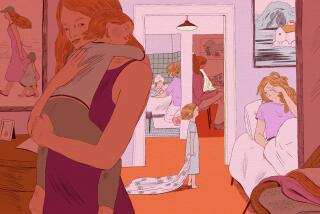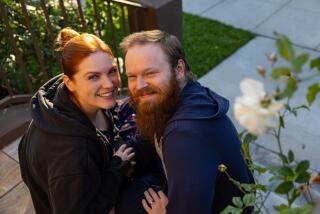THREE-KID FAMILIES : Instead of Stopping at 1 or 2 Children, Area Parents Are Filling Out the Nest
In 1985, when Steve and Pam Benkert of Canoga Park were about to have their third child, they were a rarity among their friends, most of whom had one or two children.
The Benkerts had two boys, Jeff and Scott, so whenever people saw Pam Benkert during her pregnancy they smiled and wished her luck with getting a girl this time around.
“It had nothing to do with getting a girl,” said Pam Benkert, whose third child was a girl, Kylie. “We simply wanted three children. We thought a three-child family would be perfect, regardless of their sexes.”
More than 20 offices of San Fernando Valley obstetricians and pediatricians surveyed say the Benkerts were in on the beginning of what has become a trend among Valley families: having three children.
Representatives at five major Valley hospitals--Kaiser Permanente facilities in Woodland Hills and Panorama City, Valley Presbyterian Hospital, Medical Center of North Hollywood and Humana West Hills Hospital, said they have noticed an increase in families having their third child.
“For several years there it was very uncommon to have a woman in giving birth to her third child,” one obstetrics nurse at Kaiser Permanente in Woodland Hills said. “But now it’s become more of an everyday occurrence.”
In addition, sibling classes offered at these hospitals are seeing more two-child families enrolling in preparation for their third child.
“I don’t have exact statistics, but I can see from looking at my bookings in our sibling class that there is a trend going on in which people are having three children,” said Janet Martin, coordinator of community education at Valley Presbyterian Hospital. “A majority of people who sign up for the class do have two children already.”
“At many of the local hospitals we’re seeing far more three-children families than one- and two-children families,” said Dr. Malverse Martin, chief of obstetrics and gynecology at Humana West Hills Hospital. “It is definitely a big trend.”
Martin said families desiring one child are definitely on the wane and expressed surprise at reports of a trend toward the one-child family. “Of course, many of these people can afford to have three children. That could have something to do with it,” he said.
There are many similarities among families who have decided to have a third child.
Typically, parents who make such a decision space their children three years apart and are financially able to allow one of the parents--usually the mother--to be home with the children during the day, doctors and parents said. Often the parent who stays home is not only a full-time homemaker but also does outside work from home. Many times, having a third child has brought the fathers into a more active parenting role.
And although many of the parents who have opted for three children complain about the extra cost and laundry, they say having a large family is worth such drawbacks. Many such parents, in fact, come from large families.
“Back when we decided to have three children, people were having two children, and if you had three you needed a reason,” Pam Benkert said. “There weren’t many people who had three children simply because they wanted three children.”
One Valley woman with three children said there was a time when she and her husband wouldn’t have considered having a third child. Each came from families where he or she was one of two children and had been conditioned to think that there was something wrong with having more than two children, she said.
“But then it just got to be that everyone was doing it; everyone was having three kids,” said the woman, whose third child is 4 months old. “I think if I hadn’t seen so many others having three children, I wouldn’t have done it.”
Many doctors agree that peer pressure among parents played a role in restricting the number of three-children families in the early and mid-1980s. Having more than two children was regarded as helping to overpopulate the planet, they said.
“That’s all changed now,” Martin said. “People are doing what they want to do, and what they want to do these days is have three children.”
Pediatricians said the reason for the change is most likely because of the age, maturity and wisdom of the couples choosing to have three children. These couples, usually in their 30s, feel confident about their decision-making and are therefore secure enough to plan a family with three children.
Mark and Jo Ann Tattersall of Westlake are expecting their third child in March.
“Two just seems so easy to us, and we knew we wanted three children,” said Jo Ann, who added that she and her husband both came from families with four children. “We just don’t feel complete unless we have three children.”
Art and Trisha Sandoval, both from four-child families, wanted to have three because having two didn’t feel like a family, they said. Her two sons prayed for a little sister.
“But it didn’t matter to us,” she said. “If God wanted to give us another boy, that was OK, too. We just wanted three children.”
The Sandovals said there are many advantages to having three, especially because the third child was the girl--Cassidee, now 16 months--her brothers so wanted.
“Not only do we get a lot of help from our sons,” said Trisha Sandoval of Parker, 9, and Taylor, 5, “but this time around, I’m not worrying about every cough and sniffle.”
Parents who have three agree that they are more relaxed about their third child.
“And so in some ways it’s more enjoyable,” said Annie Ventrella, a West Hills mother of three who works as a hairstylist from her home. “And because we have three girls, we actually found the third one to be less expensive than the others.”
Most parents said the third child was slightly more expensive than their second because baby equipment tends to wear out after two children.
“That means another baby swing, another crib, another car seat, another playpen,” one woman said. “And that can add up quickly.”
In fact, salesclerks at retail stores such as Baby Toytown, which carries a broad selection of baby furniture and other items, also say they have noticed more three-children families.
“There is an obvious increase in families with three children,” said one clerk at Baby Toytown. “It’s becoming more and more common for our customers to be people with three kids.”
One disadvantage of having three is watching the youngest become a middle child, said Annie Ventrella and her husband, Dave, whose youngest is nearly 2 years old. Other parents agree.
One Valley woman said that last year, in the weeks after she and her husband brought home their third child, they watched their eldest rise to new heights and their second child fall to great depths. It took nearly two months for the middle child to return to normal behavior, she said.
“We are very careful with Stephanie, our middle child, to be sure she gets as much attention and love as she did before Erica was born,” said Annie Ventrella, whose three girls are spaced three years apart. “You hear so many things about the middle-child syndrome, I think everyone having three children these days is aware of it.”
Dr. Sven Wahlroos, a licensed psychologist who has worked in the Valley for 33 years and who now runs the Family Communication Institute in Van Nuys, said the trend toward having three children may be because parents are no longer afraid of the middle-child syndrome.
The middle-child syndrome is thought to occur when the oldest child is given attention and praise for doing things first and oftentimes better than his siblings. In turn, the youngest child is showered with attention for being the baby of the family, he said. As a result, theory has it that the middle child is forgotten, taken for granted and therefore maladjusted when he or she grows up.
“That syndrome was never anything more than an old wives’ tale, perpetuated down through the years,” Wahlroos said. “In my 33 years of practice, I have never seen any evidence that a child’s problems were caused from being the middle child. These days, people are finally realizing this and are therefore no longer afraid to have three children.”
In many cases, having a third child has made many fathers aware of the importance of their role in parenting. Mark and Patti Armitage have three sons, Danny, 10, Jay, 7, and Patrick, 4, but it wasn’t until the third was born that Mark Armitage said he began to be actively involved in parenting.
“I used to have this American feeling that I’d bring home the paycheck and Patti would take care of the kids,” Mark Armitage said. “I was too busy climbing the corporate ladder to notice what was involved in taking care of the children.”
But when Patti Armitage came home from the hospital after what was her third Cesarean section delivery, it was up to her husband to take care of the other children.
Almost overnight, Mark Armitage said, he discovered it was more important to spend time with his children than to chase larger paychecks. He quit his job as a high-ranking salesman for a large electronics firm and went into business for himself.
“Today, I don’t even want that other lifestyle,” Mark Armitage said. “I needed to take my role as father and partner and leader of this family seriously. Having three children helped me do that.”
Patti Armitage said she felt stretched beyond her limits after her third son was born, and it wasn’t until her husband began taking on more parenting responsibilities that the pressure eased.
“Now it’s actually a joy to get dressed for church on Sunday mornings,” Patti Armitage said. “Families with three children definitely need both parents involved.”
Patti Armitage teaches her sons at home instead of sending them to school, and she said there is more of a school atmosphere with three students in her living room instead of two. “There’s something about having three children that fosters growth in all of them,” Mark Armitage said. “Something’s always happening, and that’s good for kids and a real blessing for us as parents.”
More to Read
Sign up for Essential California
The most important California stories and recommendations in your inbox every morning.
You may occasionally receive promotional content from the Los Angeles Times.










